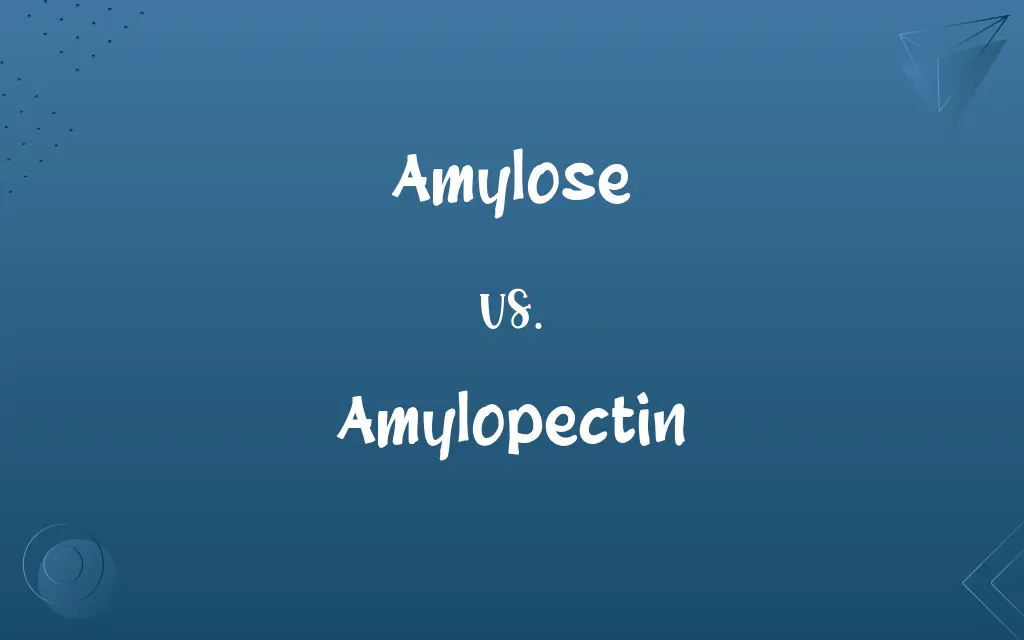Amylose vs. Amylopectin: Know the Difference

By Shumaila Saeed || Updated on December 25, 2023
Amylose is a linear polysaccharide composed of glucose units, while Amylopectin is a branched polysaccharide also made of glucose units.

Key Differences
Amylose is a simpler form of starch, primarily forming a linear and helical structure. It is made up of long, unbranched chains of glucose molecules, linked by alpha-1,4 glycosidic bonds. Amylopectin is a more complex form of starch, characterized by its highly branched structure. It consists of short chains of glucose units linked by alpha-1,4 glycosidic bonds with branches formed through alpha-1,6 glycosidic bonds.
Shumaila Saeed
Dec 23, 2023
In amylose, the linear chains tend to coil into a helical structure, which is responsible for its ability to bind with iodine, resulting in a blue-black color. Amylopectin branched structure of amylopectin allows it to be more soluble in water and gives it the ability to form a viscous solution when heated.
Shumaila Saeed
Dec 23, 2023
Amylose is less soluble in water compared to amylopectin and forms a more rigid gel when cooked. Amylopectin is the predominant component of starch, making up about 70-80% of the total starch content in plants.
Shumaila Saeed
Dec 23, 2023
Amylose has a slower digestion rate, which influences the glycemic index of foods containing it, often making them more suitable for sustained energy release. Due to its branched structure, amylopectin is digested more quickly, leading to a faster release of glucose into the bloodstream.
Shumaila Saeed
Dec 23, 2023
Comparison Chart
ADVERTISEMENT
Digestion Rate
Slower, suitable for sustained energy
Faster, quick release of glucose
Shumaila Saeed
Dec 23, 2023
Contribution to Texture
Contributes to firmness in unripe fruits
Responsible for softness in ripe fruits
Shumaila Saeed
Dec 23, 2023
ADVERTISEMENT
Impact on Glycemic Index
Lower, due to slower digestion
Higher, due to rapid digestion
Shumaila Saeed
Dec 23, 2023
Cooking Properties
Contributes to resilience of cooked foods
Responsible for thickening of sauces and gravies
Shumaila Saeed
Dec 23, 2023
Amylose and Amylopectin Definitions
Amylose
Amylose is a component of starch, characterized by its unbranched structure.
The amylose content in potatoes affects their texture after boiling.
Shumaila Saeed
Dec 13, 2023
ADVERTISEMENT
Amylopectin
Amylopectin is the major component of starch, contributing to its viscous nature.
The high amylopectin content in sticky rice gives it its unique texture.
Shumaila Saeed
Dec 13, 2023
Amylose
Amylose is known for its role in determining the glycemic index of foods.
Foods high in amylose, like some varieties of rice, provide a slower release of energy.
Shumaila Saeed
Dec 13, 2023
Amylopectin
Amylopectin reacts with iodine to form a reddish-brown color.
When testing for starch, amylopectin's presence is shown by a reddish-brown hue.
Shumaila Saeed
Dec 13, 2023
Amylose
Amylose forms a blue-black complex when treated with iodine.
In the iodine test, the presence of amylose is indicated by a blue-black coloration.
Shumaila Saeed
Dec 13, 2023
Amylopectin
Amylopectin is a branched polysaccharide composed of glucose units with alpha-1,4 and alpha-1,6 glycosidic bonds.
The branched structure of amylopectin makes it more soluble in water.
Shumaila Saeed
Dec 13, 2023
Amylose
Amylose is less soluble in water compared to amylopectin.
The lower solubility of amylose in water affects the cooking properties of certain starches.
Shumaila Saeed
Dec 13, 2023
Amylopectin
Amylopectin is rapidly digested, influencing the glycemic index of foods.
Foods with high amylopectin content, like white bread, tend to raise blood sugar levels quickly.
Shumaila Saeed
Dec 13, 2023
Amylose
Amylose is a linear polysaccharide composed of glucose units linked by alpha-1,4 glycosidic bonds.
Amylose in rice contributes to its firm texture when cooked.
Shumaila Saeed
Dec 13, 2023
Amylopectin
Amylopectin contributes to the soft texture of ripe fruits and thickening of sauces.
The softness of ripe bananas is partly due to their amylopectin content.
Shumaila Saeed
Dec 13, 2023
Amylose
A linear, unbranched polysaccharide that is one of the two main components, along with amylopectin, of starches.
Shumaila Saeed
Dec 08, 2023
Amylopectin
A highly branched polysaccharide of high molecular weight that is one of the two main components, along with amylose, of starches.
Shumaila Saeed
Dec 08, 2023
Amylose
(carbohydrate) The soluble form of starch (the insoluble form being amylopectin) that is a linear polymer of glucose.
Shumaila Saeed
Dec 08, 2023
Amylopectin
(carbohydrate) A highly branched, insoluble form of starch (the soluble form being amylose)
Shumaila Saeed
Dec 08, 2023
Amylose
One of the starch group (C6H10O5)n of the carbohydrates; as, starch, arabin, dextrin, cellulose, etc.
Shumaila Saeed
Dec 08, 2023
Repeatedly Asked Queries
What is amylose?
Amylose is a linear polysaccharide found in starch, composed of glucose units linked by alpha-1,4 glycosidic bonds.
Shumaila Saeed
Dec 23, 2023
How does amylose differ from amylopectin in structure?
Amylose has a linear structure, while amylopectin is branched.
Shumaila Saeed
Dec 23, 2023
Why is amylose less soluble in water than amylopectin?
Amylose's linear structure makes it less soluble compared to the branched structure of amylopectin.
Shumaila Saeed
Dec 23, 2023
What is the significance of the iodine test for amylose and amylopectin?
The iodine test distinguishes between amylose and amylopectin based on the color change (blue-black for amylose, reddish-brown for amylopectin).
Shumaila Saeed
Dec 23, 2023
What is amylopectin?
Amylopectin is a branched polysaccharide that makes up the majority of starch, with alpha-1,4 and alpha-1,6 glycosidic bonds.
Shumaila Saeed
Dec 23, 2023
How does amylopectin affect the cooking properties of starch?
Amylopectin contributes to the thickening and viscosity of starches when cooked.
Shumaila Saeed
Dec 23, 2023
Does the amount of amylose affect the texture of food?
Yes, higher amylose content usually results in a firmer texture in foods.
Shumaila Saeed
Dec 23, 2023
How does the digestion rate of amylose and amylopectin differ?
Amylose is digested slower than amylopectin, affecting the glycemic index of foods.
Shumaila Saeed
Dec 23, 2023
Does amylopectin impact the glycemic index of foods?
Yes, due to its rapid digestion, amylopectin can increase the glycemic index of foods.
Shumaila Saeed
Dec 23, 2023
Can the proportion of amylose and amylopectin in starch vary?
Yes, different plants and starch sources have varying proportions of amylose and amylopectin.
Shumaila Saeed
Dec 23, 2023
Are there any industrial uses for amylose and amylopectin outside of food?
Yes, they are used in various industries for their thickening and stabilizing properties.
Shumaila Saeed
Dec 23, 2023
Is amylose responsible for the firmness of unripe fruits?
Yes, amylose contributes to the firm texture of unripe fruits.
Shumaila Saeed
Dec 23, 2023
How do the gel formation properties of amylose and amylopectin differ?
Amylose forms a rigid gel, while amylopectin forms a more viscous solution.
Shumaila Saeed
Dec 23, 2023
Can the amylose and amylopectin content be altered in crops through breeding?
Yes, selective breeding and genetic modification can alter the amylose and amylopectin content in crops.
Shumaila Saeed
Dec 23, 2023
Do all plants contain both amylose and amylopectin?
Most plants contain both, but the proportions can vary widely.
Shumaila Saeed
Dec 23, 2023
Are there any health implications related to amylose and amylopectin?
Yes, their different digestion rates can affect blood sugar levels and dietary considerations.
Shumaila Saeed
Dec 23, 2023
Can the ratio of amylose to amylopectin affect food allergies or intolerances?
Not typically, but it can affect digestibility and glycemic response.
Shumaila Saeed
Dec 23, 2023
How does the presence of amylose and amylopectin affect the storage of starch in plants?
Their structural differences influence how efficiently starch can be stored and mobilized in plants.
Shumaila Saeed
Dec 23, 2023
What role does amylopectin play in ripe fruits?
Amylopectin contributes to the softness and sweetness of ripe fruits.
Shumaila Saeed
Dec 23, 2023
Is it possible to separate amylose from amylopectin in a laboratory?
Yes, using certain techniques, amylose and amylopectin can be separated for analysis.
Shumaila Saeed
Dec 23, 2023
Share this page
Link for your blog / website
HTML
Link to share via messenger
About Author
Written by
Shumaila SaeedShumaila Saeed, an expert content creator with 6 years of experience, specializes in distilling complex topics into easily digestible comparisons, shining a light on the nuances that both inform and educate readers with clarity and accuracy.




































































